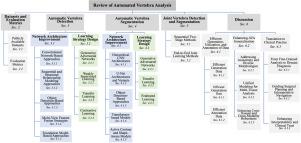用于自动椎体分析的深度学习:最近进展的方法学调查。
IF 4.9
2区 医学
Q1 ENGINEERING, BIOMEDICAL
Computerized Medical Imaging and Graphics
Pub Date : 2025-10-01
DOI:10.1016/j.compmedimag.2025.102652
引用次数: 0
摘要
自动椎体分析(AVA),包括椎体检测和分割,在脊柱相关临床工作流程的计算机辅助诊断、手术计划和术后评估中起着至关重要的作用。尽管取得了显著进展,但AVA仍然面临着关键挑战,包括视场(FOV)的变化,复杂的椎体形态,高质量注释数据的可用性有限,以及域转移下的性能下降。在过去的十年中,许多研究都采用深度学习(DL)来解决这些问题,引入了先进的网络架构和创新的学习范式。然而,这些方法的快速发展并没有被现有的调查全面地捕捉到,从而导致了关于该领域现状的知识差距。为了解决这个问题,本文提出了一个最新的评论,系统地总结了最近的进展。审查从整合公开可用的数据集和评估指标开始,以支持标准化基准测试。然后从两个方法学角度分析了最近基于dl的AVA方法:网络架构改进和学习策略设计。最后,对持续存在的技术障碍和正在形成未来研究方向的新临床需求进行了检查。这些包括多模态学习、领域泛化和基础模型的集成。作为该领域最新的调查,本综述提供了一个全面和结构化的综合,旨在指导未来研究在智能医学成像时代开发健壮、通用和临床可部署的AVA系统。本文章由计算机程序翻译,如有差异,请以英文原文为准。

Deep learning for automatic vertebra analysis: A methodological survey of recent advances
Automated vertebra analysis (AVA), encompassing vertebra detection and segmentation, plays a critical role in computer-aided diagnosis, surgical planning, and postoperative evaluation in spine-related clinical workflows. Despite notable progress, AVA continues to face key challenges, including variations in the field of view (FOV), complex vertebral morphology, limited availability of high-quality annotated data, and performance degradation under domain shifts. Over the past decade, numerous studies have employed deep learning (DL) to tackle these issues, introducing advanced network architectures and innovative learning paradigms. However, the rapid evolution of these methods has not been comprehensively captured by existing surveys, resulting in a knowledge gap regarding the current state of the field. To address this, this paper presents an up-to-date review that systematically summarizes recent advances. The review begins by consolidating publicly available datasets and evaluation metrics to support standardized benchmarking. Recent DL-based AVA approaches are then analyzed from two methodological perspectives: network architecture improvement and learning strategies design. Finally, an examination of persistent technical barriers and emerging clinical needs that are shaping future research directions is provided. These include multimodal learning, domain generalization, and the integration of foundation models. As the most current survey in the field, this review provides a comprehensive and structured synthesis aimed at guiding future research toward the development of robust, generalizable, and clinically deployable AVA systems in the era of intelligent medical imaging.
求助全文
通过发布文献求助,成功后即可免费获取论文全文。
去求助
来源期刊
CiteScore
10.70
自引率
3.50%
发文量
71
审稿时长
26 days
期刊介绍:
The purpose of the journal Computerized Medical Imaging and Graphics is to act as a source for the exchange of research results concerning algorithmic advances, development, and application of digital imaging in disease detection, diagnosis, intervention, prevention, precision medicine, and population health. Included in the journal will be articles on novel computerized imaging or visualization techniques, including artificial intelligence and machine learning, augmented reality for surgical planning and guidance, big biomedical data visualization, computer-aided diagnosis, computerized-robotic surgery, image-guided therapy, imaging scanning and reconstruction, mobile and tele-imaging, radiomics, and imaging integration and modeling with other information relevant to digital health. The types of biomedical imaging include: magnetic resonance, computed tomography, ultrasound, nuclear medicine, X-ray, microwave, optical and multi-photon microscopy, video and sensory imaging, and the convergence of biomedical images with other non-imaging datasets.

 求助内容:
求助内容: 应助结果提醒方式:
应助结果提醒方式:


